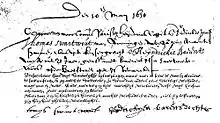Tomys Swartwout
'Thomas or Tomys Swartwout (June 1, 1607, Groningen – 1660, Beverwijck)[1] was one of the earliest importers of tobacco from New Netherland to western and northern Europe, one of earliest settlers of New Netherland (present day United States), and a founder of Midwood (originally Midwout), Brooklyn, New York.

Tomys Swartwout | |
|---|---|
| Born | June 1, 1607 |
| Died | 1660 |
| Spouse(s) | Adrijejtjen Sijmons
(m. 1630; died 1630)Hendrickjen Otsen
(m. after 1631) |
| Children | 5, including Roeloff Swartwout |
| Parent(s) | Rolef Swartwout Catryna Swartwout |
Early life
Tomys Swartwout was born in 1607 in Groningen, Netherlands to Rolef Swartwout (1575–1634) and Catryna Swartwout (b. 1579).[2] Swartwout was one of the earliest New Netherlanders to buy and sell American tobacco in the Netherlands. He started a wholesale tobacco business in Amsterdam, joining his older brothers, Wybrant and Herman, in 1629.[3]
New Amsterdam
Swartwout and family left Amsterdam for New Netherland in March 1652. Swartwout, Jan Snedeker and Jan Stryker solicited from Director-General Peter Stuyvesant the right to settle together on the level reach of wild land (de vlacke bosch) or flat bush, adjacent to the outlying farms at Breukelen and Amersfoort. Through Swartwout's suggestion, the settlement was given the name of the village of Midwout. In April 1655, Stuyvesant and the Council of New Netherland appointed Swartwout a schepen (magistrate),[3] to serve with Snedeker and Adriaen Hegeman as the Court of Midwout.[4] Being one of the original settlers, Tomys Swartwout was granted letters-patent by the Council of New Netherland, Director-General Stuyvesant, and the Dutch West India Company of 116 acres on April 13, 1655.[3]
Swartwout was one of the nineteen signers of the "Humble Remonstrance and Petition of the Colonies and Villages of this New Netherland Province" sent to Stuyvesant on December 11, 1653, an important early document in the campaign for democracy in America.[2] Following Adriaen Van Der Donck's Remonstrance of 1650 about governance of the colony, the document signed by Swartout set out discontents about Stuyvesant's authoritarian method of personally selecting, rather than electing, the council. The statement later inspired Jacob Leisler's campaign late in the 1680s for fuller representative democracy in New Amsterdam.[5][6]
Personal life
In March 1630, he married Adrijejtjen Sijmons in Amsterdam. She died in child birth nine months later on December 17, 1630 after giving birth to their only child, Jan Swartwout. On June 3, 1631, he married Hendrickjen Otsen (b. 1609), with whom he would have several children, Roeloff (1634–1715), the founder of Kingston and Hurley, Barent, Tryntje, and Jacomijntje.[1]
Swartwout died in 1660 in Beverwijck, New Netherland.[2]
References
- Thomas Swartwout genealogy page
- Saint Nicholas Society of the City of New York (1905). The Saint Nicholas Society of the City of New York: History, Customs, Record of Events, Constitution, Certain Genealogies, and Other Matters of Interest. V. 1-. The Society. Retrieved 28 August 2017.
- Weise, Arthur James (1899). The Swartwout Chronicles (PDF).
- B, O'Callaghan, E. (1865-01-01). The register of New Netherland, 1626 to 1674. Albany, N.Y: J. Munsell. p. 74. OL 6906821M.
- Nelson, William E. (2008-01-01). The Common Law in Colonial America: Volume II: The Middle Colonies and the Carolinas, 1660-1730. OUP USA. ISBN 9780199937752.
- Brink, Andrew (2003-06-06). Invading Paradise: Esopus Settlers at War with Natives, 1659, 1663. Xlibris Corporation. ISBN 9781465317629.